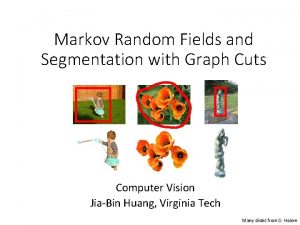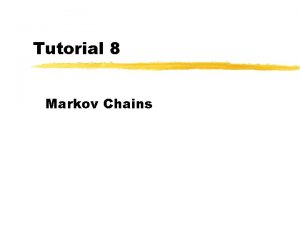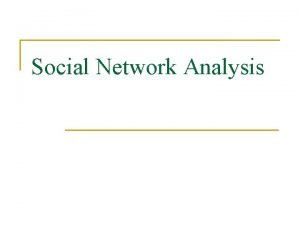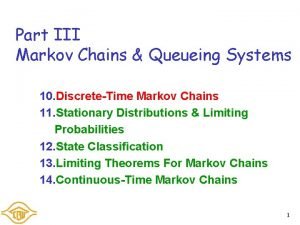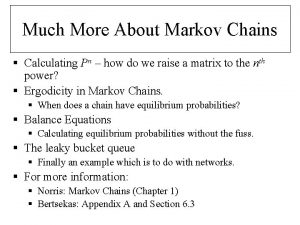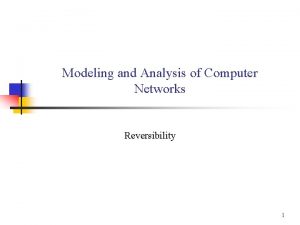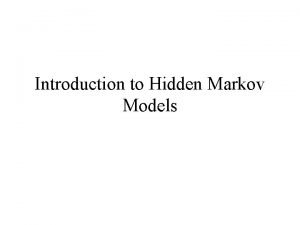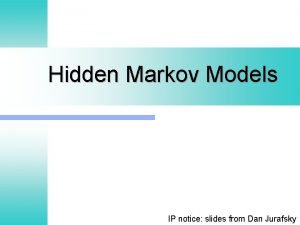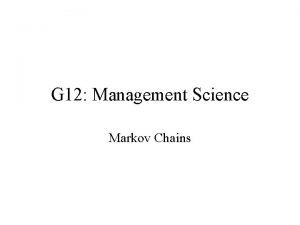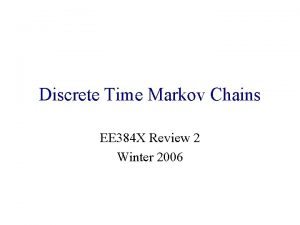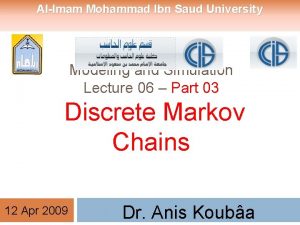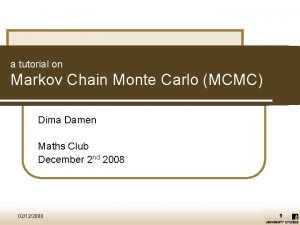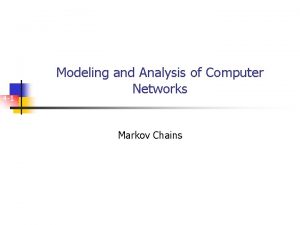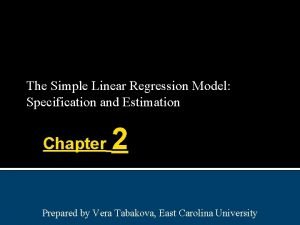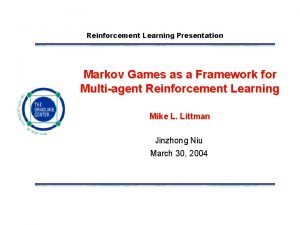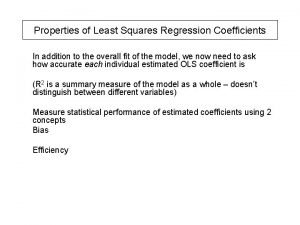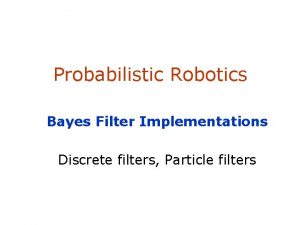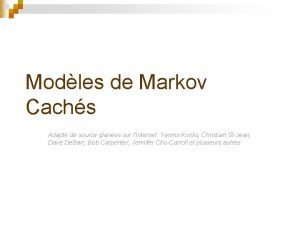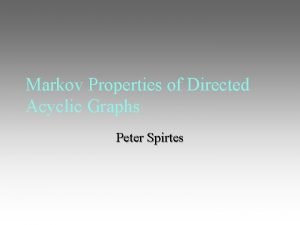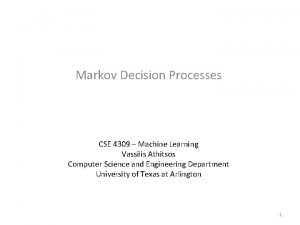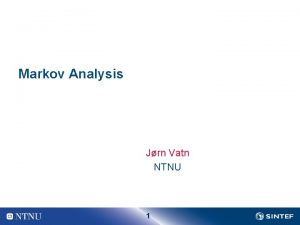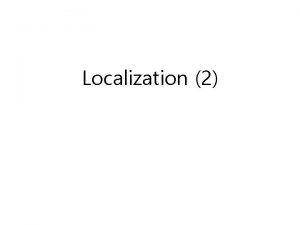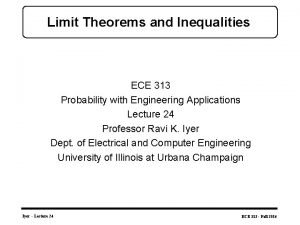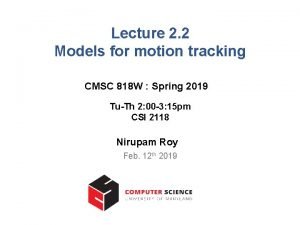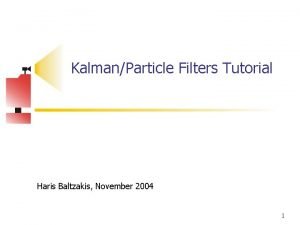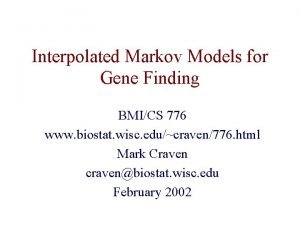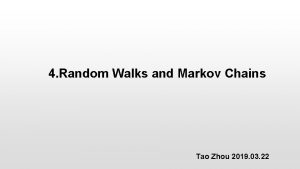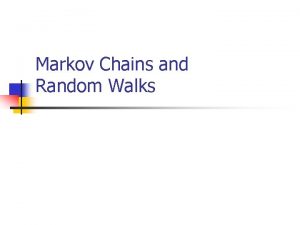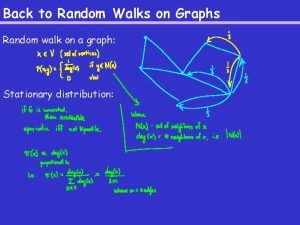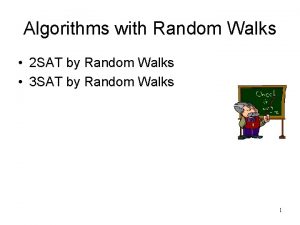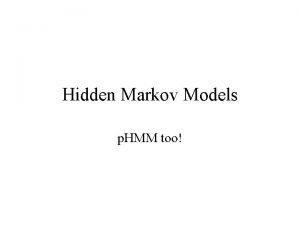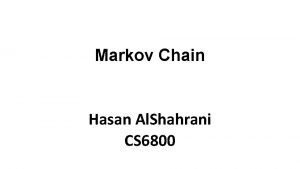Chapter 16 Markov Chain Random Walks Mc CTRWs
















































- Slides: 48

+ Chapter 16 – Markov Chain Random Walks Mc. CTRWs – the fast food of random walks

+ Overview We are in the home stretch now and this last topic is one that is very dear to my heart as it is something that I worked very actively on myself. One of my close friends who was a postdoc in Spain at the same time as me actually ‘invented’ this method and he and I have continued to work on it a lot (including that this is a core part of Nikki’s Ph. D thesis). We have run this model in many different problems and so far it has proven itself robust to almost any challenge we have thrown its way…. What we still do not know how to do is how to parameterize it for real data from real systems. . But we’re getting there.

+ Basic Premise of Most Random walk Models Our particle position and time equations are given by x and t are random numbers. We have considered them with finite mean and variance, infinite variance and infinite mean and shown all sorts of behaviors, but we have still always assumed one thing I. I. D (Independent and Identically Distributed)

+ IID Identically Distributed – this means that the random number is always drawn from the same distribution. How might you relax this? Do you think it’s important? In what context? Independent What do you mean by independent? Does this make sense to you How might we relax this assumption and when is it important?

+ Consider the following classical problem Flow between two flat plates y x We already know from our work on Taylor dispersion how this system will behave at late times (t>L^2/D) But what about at earlier times than this? Can we use some of the CTRW ideas we have discussed to date?

How about this? + Define some distance Dx y x Dx I can measure how much time it takes particles to move this distance, right? Therefore I can say x=0, Dx is fixed, Dt=0 and t is random And now I just run my CTRW, right? And because p(t) has finite mean and variance it will converge to Fickian Dispersion (which I expect from Taylor’s theory) – Foresee any issues?

+ Let’s test it Consider the following case U=3/2 (1 -y^2) -1<y<1 (parabolic flow between two plates) Let’s consider Dx=10 (you can pick whatever you want – within limits as Nikki has discovered, but lets not get sidetracked by that) Test our idea for D=0. 1, 0. 01 and 0. 001 Basically, I run a particle tracking simulation with a pulse initial condition at x=0 (represented by N particles) and then measure how long it takes each particle to travel a distance of Dx=10. This then gives me a vector of N travel times that I can sample from to make the next jump over Dx=10 (i. e. to 20) Let’s test this model’s ability to predict breakthrough at x=20, 40 and 100

+ Step 1 – Measure travel time distribution Run the code rw_ptau. m Note here that we use what is called a flux weighted initial condition (just for ease) This code runs a random walk that resolves the velocity field, i. e. In this code we store the vector, called timer, that measures the amount of time it takes each particle to cross a distance Dx=10. Save timer

+ Step 2 – Generate data for comparison Run the same random walk code that models everything too Measure BTCs at further distances – rw_btcs. m Measure the amount of time it takes particles to travel a distance of 20, 40 and 100, which allows us to build brreakthrough curves btc 20, btc 40 and btc 100.

+ Step 3 - Run our “Upscaled” Model We now run a code that implements a CTRW and no longer resolves the velocity field, but aims to capture the different speeds of each particle by saying it takes a random time to cross a distance Dx. That random time is chosen from the vector timer. Sampled randomly from timer Run this code to generate arrival times/BTCs for x=20, 40, 100

+ Step 4 – Compare the model outputs Run the code compare. m The code plot the BTCs at x=20, 40 and 100 for both the fully resolved and upscaled CTRW model.

+ For D=0. 1 Step 1 – Generate Timer

+ For D=0. 1 Step 2– Generate BTCs

+ For D=0. 1 Step 3 – Run CTRW

+ For D=0. 1 Step 4 – Compares Virtually Indistinguishable

+ For D=0. 01 Step 1 – Generate Timer

+ For D=0. 01 Step 2– Generate BTCs

+ For D=0. 01 Step 3 – Run CTRW

+ For D=0. 01 Step 4 – Compares Not terrible But certainly Not Indistinguishable

+ For D=0. 001 Step 1 – Generate Timer

+ For D=0. 001 Step 2– Generate BTCs

+ For D=0. 001 Step 3 – Run CTRW

+ For D=0. 001 Step 4 – Compares Seems to be getting even worse

+ So what is going on? For large D the proposed CTRW model looks pretty good… As D gets smaller the match between model and measured gets worse and worse – WHY? What is different from the perspective of the CTRW model as D get smaller and smaller? How might you address this? And thereby improve our model so that we can match predicted and observed consistently across a range of values of D?

+ What is missing? The CTRW as we have defined it assumes that successive jumps in time are completely uncorrelated and independent of one another. Our simulations suggest that this may only be true for large diffusion coefficients – does this align with your intuition? As D gets smaller particles are likely to stay on similar streamlines and so it is likely that successive ts will not be independent. How can measure and thus impose such correlation

+ Travel Time Distribution Dx 1 t 1 Dx 2 t 2 If uncorrelated I just sample arbitrarily from p(t)

+ Travel Time Distribution Dx 1 t 1 Dx 2 t 2 Imagine I pick a specific value of t 1 as shown. Now because of correlation t 2 is restricted where it can come from

+ Let’s break p(t) into bins – for sake of depiction say 4 Dx 1 t 1 1 2 3 Dx 2 t 2 4 What correlation is saying is that t 2 can only come from bin 2 or 3 now and we can measure the probability that it comes from bin 2 or bin 3.

+ What we have to measure Dx 1 t 1 Dx 2 t 2 Run a simulation with N particles (say N=one million) and for each particle measure how long it takes to cross Dx 1 and how long it takes to cross Dx 2 The distribution of the two should be the same Now break p(t) into M bins and attribute each particles t 1 to one bin and each particles t 2 to a bin. Measure how likely it is that a particle with t 1 from one bin has a t 1 from another one and represent it as a matrix

+ Let’s break p(t) into bins – for sake of depiction say 4 Dx 1 t 1 1 2 3 Dx 2 t 2 4 1 2 3 4 What correlation is saying is that t 2 can only come from bin 2 or 3 now and we can measure the probability that it comes from bin 2 or bin 3.

+ Transition Matrix 1 2 1 0. 8 0. 2 0 0 2 0. 1 0. 7 0. 2 0 3 0 0. 15 0. 75 0. 1 4 0 0 (Initial Bin) 3 0. 3 4 0. 7 (Next Bin) How to read this If t 1 comes from bin 1 then it has an 80% chance that t 2 will be from bin 1 and 20% that it will be from bin 2 and 0% chance from bins 3 or 4 If t 1 comes from bin 3 then it has an 0% chance that t 2 will be from bin 1 and 15% that it will be from bin 2, 75% from bin 3 and 10% chance from bin 4 Thus, I randomly generate t 1 from p(t). Then I generate another random number to assess where t 2 will come from and then only sample from that bin. I generate a new number to assess where t 3 will come from based on t 2 and so on until I have jumped my desired number of steps

+ Example – same case as before with D=0. 001 (where CTRW did not work) Recall this is what p(t) looked like If will break this into 25 bins The higher the number of bins the better you resolve correlation – typically 25 -50 is good.

+ Check that indeed p(t) is the same for t 1 and t 2 Run code rw_ptau_2 dx. m

+ Measure the transition matrix Run code transition_matrix. m Bin 1 is the smallest travel times (i. e. fastest particles). Bin 25 is the largest travel times (slowest particles) t 1 t 2

+ Cumulative Transition Matrix This Matrix adds columns together… last column has to be 1 Why would I do this? Easier for coding… You know t 1, which means you know which row you are in. To determine next bin generate a random number U=[0, 1] This determines your next bin by looking along the columns. .

+ Now use this transition matrix to enforce correlations in a CTRW code See code mcctrw. m (sample below)

+ How does this compare… Recall this is what we want to reproduce…

+ This is what the CTRW without correlation gave us Not a good match

+ How about our new algorithm… Almost perfect. . Including correlation the way we have seems to fix the issues What about larger D?

+ For D=0. 01 What uncorrelated model gave us Better than smaller D But not Perfect

+ What does transition matrix look like for our new model? Compare to smaller D

+ What does transition matrix look like for our new model? D=0. 01 D=0. 001 What’s different – Does it make sense to you?

+ How about our new algorithm… Almost perfect. . Including correlation the way we have seems to fix the issues What about larger D?

+ Finally for largest D=0. 1 What uncorrelated model gave us Virtually Indistinguishable

+ Transition Matrix for this Case Again, compare to before and does it make sense?

+ Comparison Again, virtually perfect (but unnecessary to include correlations)

+ Summary of Algorithm for Mc. CTRW Step 1 – Generate a random number t 1 from p(t) Step 2 – Determine what bin is t 1 in Step 3 – Generate a random number and use transition matrix to assess what the next bin will be Step 4 – Generate t 2 from the new bin Step 5 - Generate a random number and use transition matrix to assess what the next bin will be Step 6 – Generate t 3 from the new bin And so on until the desired number of jumps have passed.

+ Ok – it works for flow between two plates – does it work in other flows? For this let’s dig in the litterature… Thursday
 He who walks with integrity walks securely meaning
He who walks with integrity walks securely meaning Markov random field
Markov random field Random walks
Random walks Food chain food chain food chain
Food chain food chain food chain Markov chains tutorial
Markov chains tutorial Absorbing state
Absorbing state Veton kepuska
Veton kepuska Bing
Bing Embedded markov chain
Embedded markov chain Markov chain natural language processing
Markov chain natural language processing Aperiodic markov chain
Aperiodic markov chain Birth and death process examples
Birth and death process examples Aperiodic markov chain
Aperiodic markov chain Aperiodic markov chain
Aperiodic markov chain Aperiodic markov chain
Aperiodic markov chain Hidden markov chain
Hidden markov chain Hidden markov chain
Hidden markov chain Aperiodic markov chain
Aperiodic markov chain Aperiodic markov chain
Aperiodic markov chain Transient markov chain
Transient markov chain Mcmc tutorial
Mcmc tutorial Embedded markov chain
Embedded markov chain Riset operasi
Riset operasi Who walks the golden chain of lukomorye
Who walks the golden chain of lukomorye Random assignment vs random sampling
Random assignment vs random sampling Random assignment vs random selection
Random assignment vs random selection Difference between logistics and supply chain
Difference between logistics and supply chain Open kinetic chain definition
Open kinetic chain definition Gauss markov assumptions
Gauss markov assumptions What is markov analysis
What is markov analysis Hidden markov model rock paper scissors
Hidden markov model rock paper scissors Mdp example
Mdp example Gauss markov assumptions
Gauss markov assumptions Cov(ui uj)=0
Cov(ui uj)=0 Markov localization
Markov localization Hidden markov model tutorial
Hidden markov model tutorial Local markov assumption
Local markov assumption Markov decision process merupakan tuple dari
Markov decision process merupakan tuple dari Markov model
Markov model Markov decision
Markov decision Martin l. puterman
Martin l. puterman Jørn vatn
Jørn vatn Markov localization
Markov localization Ratio test rules
Ratio test rules Markov localization
Markov localization Markov localization
Markov localization Interpolated markov model
Interpolated markov model Interpolated markov model
Interpolated markov model Hr utility
Hr utility

